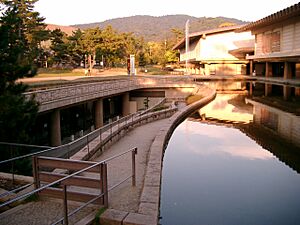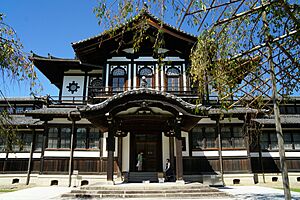Nara National Museum facts for kids
| 奈良国立博物館 | |

Original Museum Building
|
|
| Established | 1889 |
|---|---|
| Location | Nara, Japan |
| Type | Art museum |
The Nara National Museum (奈良国立博物館 (Nara Kokuritsu Hakubutsukan)) is one of Japan's most important national art museums. It is famous for its amazing collection of Buddhist art.
Contents
About the Museum
The Nara National Museum is located in Nara, a city that was once the capital of Japan. This was a long time ago, from the years 710 to 784.
The first building of the museum was designed by Katayama Tōkuma. It is a great example of Western-style buildings from the Meiji period (1868-1912). This building is so special that it has been named an Important Cultural Property in Japan. Later, Junzō Yoshimura designed another building for the museum in 1973.
What You Can See: Collections
The museum is well-known for its collection of Buddhist art. This includes many different items like images, sculptures, and special objects used on altars. The museum also keeps and shows artworks that belong to temples and shrines in the Nara area.
Every autumn, the museum displays special items from the Shōsōin repository. This is a famous treasure house that holds many ancient and valuable objects.
Some of the amazing artworks in the museum's collection include:
- The 12th-century Hell Scroll (Nara National Museum) (地獄草紙), which is a very old scroll.
- An 11th or 12th-century mandala called Jōdo mandara-zu. A mandala is a special kind of art that shows spiritual maps or symbols.
- A 9th-century sculpture of the seated Buddha Yakushi.
Museum History
The Nara National Museum first opened in 1889. It was originally called the Imperial Nara Museum. The very first exhibition was held in 1895. Before the museum even opened, there was a special Nara exhibition in 1874. This was set up by the Nara governor, Fujii Chihiro.
Over the years, the museum's name changed a few times. It became the Imperial Household Museum of Nara. Finally, in 1952, it was given its current name: the Nara National Museum.
Key Dates in Museum History
Here's how the museum grew and changed over time:
- 1889: The museum was created as the "Imperial Museum of Nara."
- 1895: The first exhibition opened to the public.
- 1900: The museum was renamed the "Imperial Household Museum of Nara."
- 1914: A special department for the Shōsōin treasures was added.
- 1947: The government's Imperial Household Ministry handed over responsibility for the museum's collections to the Ministry of Education.
- 1952: The museum was officially renamed the "Nara National Museum."
- 1969: The original museum building was recognized as an "Important Cultural Property."
- 1972: A new exhibition building, called the West Wing, was finished.
- 1980: The Buddhist Art Library opened.
- 1995: The museum celebrated its 100th anniversary.
- 1997: The East Wing and an underground walkway were completed.
- 2001: The museum became part of the "Independent Administrative Institution National Museum" (IAI National Museum).
- 2005: The IAI National Museum grew to include the Kyushu National Museum.
- 2007: The IAI National Museum joined with other cultural preservation groups to form the Independent Administrative Institution National Institutes for Cultural Heritage (NICH).
Museum Buildings and Areas
Original Museum Building
The first museum building was designed by Katayama Tōkuma. He was an architect for the Imperial Household Agency. This building was finished in 1894. It is built in the French Renaissance style, which was popular at the time. It's especially known for its beautiful decorations around the West Entrance. This building is a great example of European architecture from the middle Meiji period. The government officially named this exhibition hall an Important Cultural Property in 1969.
East and West Wings
These newer parts of the museum were designed by Junzō Yoshimura. The West Wing started being built in 1970 and was finished in 1972. The East Wing opened in 1998. The East Wing's design matches the style of the West Wing.
Lower Level Passageway
This underground walkway connects the East and West Wings with the Original Museum Building. Inside, you'll find the Museum Shop and a Lounge & Restaurant. Along the sides of the passageway, there are displays with models and pictures that explain how Buddhist sculptures are made. You don't need a museum ticket to walk through this 150-meter-long corridor. It's a nice place for visitors and the public to relax.
Buddhist Art Library
The Research Center for Buddhist Art opened in 1980. Its job is to collect, organize, and store books, copies, photos, and other materials related to Buddhist art. The library and photo archives have been open to the public since 1989. They are mainly used by researchers who study Buddhist art.
Hassoan Tea House
The Hassoan (八窓庵) is a traditional Japanese tea ceremony house located in the museum's inner garden. It was originally built on the grounds of Daijo-in, a sub-temple of Kōfuku-ji Temple. This tea house was built during the middle Edo period. It is famous for having many windows, which was a favorite style of the tea master Furuta Oribe. Hassoan is considered one of the Three Great Tea Houses of Nara, along with Rokusoan in the Kōfuku-ji and Okiroku in the Tōdai-ji.
The Hassoan has a tea room with four tatami mats and a special alcove called a tokonoma. It has a rustic style, with a thatched roof. Inside, parts of the ceiling are covered with rush, while other areas show the underside of the roof.
To protect this special tea house, people in Nara asked for Hassoan to be moved to the Imperial Nara Museum in 1890. It was moved onto the museum grounds in 1892.
Conservation Center
The Conservation Center opened in 2002. Its main purpose is to help save, examine, document, and restore National Treasures and other important cultural items. Experts who specialize in restoring sculptures, paintings, and old texts work here. They also give advice to people who own or care for cultural treasures.
See also
- List of National Treasures of Japan (ancient documents)
- List of National Treasures of Japan (archaeological materials)
- List of National Treasures of Japan (crafts-others)
- List of National Treasures of Japan (paintings)
- List of National Treasures of Japan (sculptures)
- List of National Treasures of Japan (writings)
- Agency for Cultural Affairs
- National Institutes for Cultural Heritage



